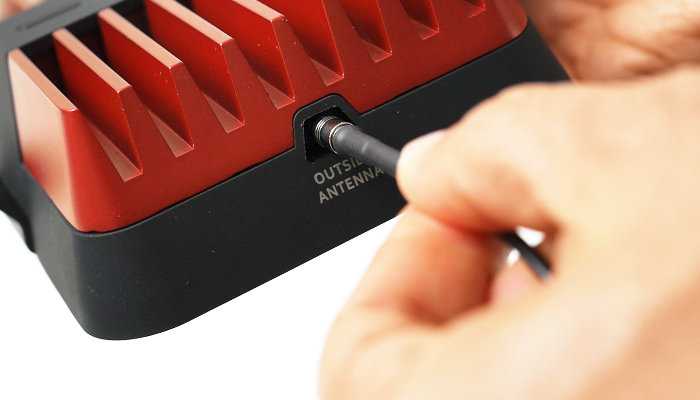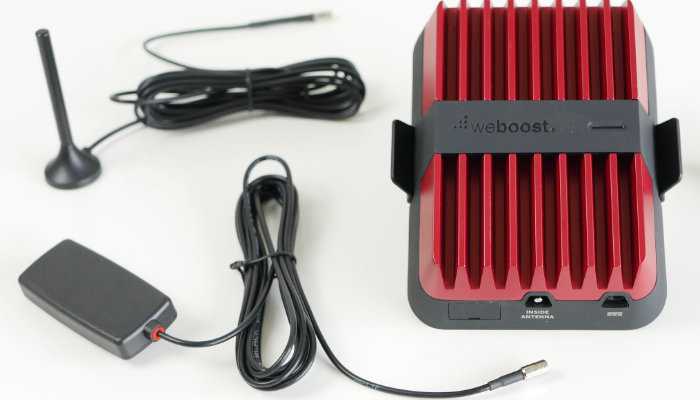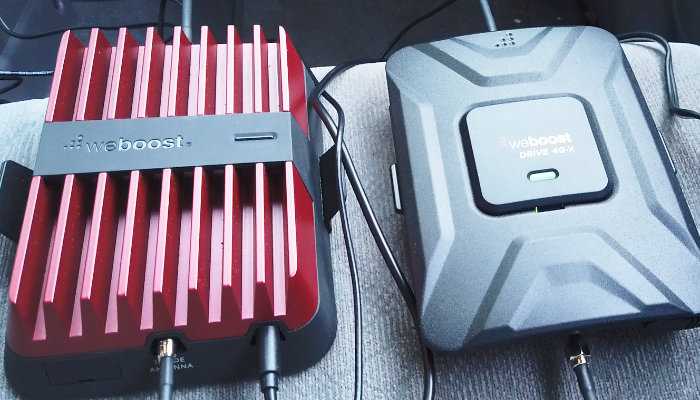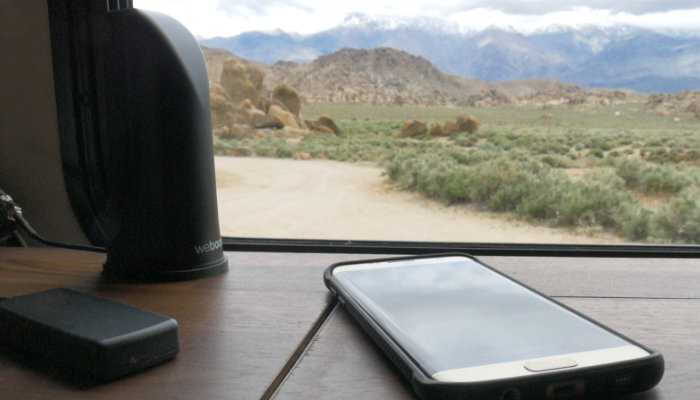The Drive Reach is the latest mobile vehicle cell phone booster from Weboost. Available for purchase in May 2019, the Drive Reach is very nice looking with a bold new red look and sturdy metal case. Both the Drive Reach and its predecessor, the Drive 4G-X, can boost cell phone signals up to 50 dB. So what’s new?
Weboost claims the Drive Reach is more powerful than the Drive X (formerly Drive 4G-X) because it has a higher uplink power level. The increase in uplink power enables you to “reach” cell towers beyond the range of other mobile boosters including the Drive X. Since mobile communication is bi-directional, this should also improve overall signal quality.
I wanted to see if this was true. So I compared the components of both boosters and did some side-by-side testing of the Drive Reach against the Drive X. I hope this comparison helps you decide which mobile booster is best for you.
What Improvements Do The Drive Reach Have?
The first thing I noticed about the Drive Reach is it’s bold new red look. It really looks nice and grabbed my attention as soon as I cracked open the box. I took a closer look I noticed these other improvements.
Double the Range of Previous Boosters
The increase in uplink power to 29.5 dBm doubles the range of the Drive Reach over previous booster models. This is a significant improvement allowing you to reach cell towers from twice as far compared to previous models like the Drive X.
Solid Red Metal Construction Is Not Just for Looks
When I picked up the booster, I noticed how heavy and solid it was. The top is one big red metal heat sink that should help keep the unit cooler. Other boosters from Weboost, like the Drive X and Connect RV 65, are very light weight with plastic bodies. They tend to get hot when in use. Sometimes the coax connector is almost too hot to touch. A cooler running Drive Reach should allow it to operate more efficiently.
Easy Antenna Connections

Antenna connections to the base unit are easy push-style SMB coax connectors. To connect the cables, just push it in until it clicks and pull it out to disconnect. There’s no need to fumble with tiny threaded connectors.
Basic Antennas
The Drive Reach package I tested comes with a small magnetic mounted external antenna and small flat mountable antenna for inside the vehicle.

Mounting the external antenna to a metal roof is as easy as putting it on the roof. The internal antenna can be mounted to your dashboard with an adhesive strip or velcro, both of which are provided.
Antenna Options
Weboost typically provides several antenna packages for each booster model. Previous models included auto, RV, First Reponders (fleet), and trucking (OTR) models with antennas well suited for each application. The fleet model has a NMO antenna and hard-wire power connection. Everything else is the same as the standard auto model.
The Drive Reach RV kit (released in November 2020) includes an OTR style antenna, tabletop in-vehicle antenna, and all RV mounting and installation hardware. See my Review of the Drive Reach RV.
rvwithtito.com
If you have other antennas you’d like to try with the Drive Reach, you should know that the Drive Reach has SMB coax connectors and not F-Type connection. To connect antennas with F-type connectors, you’ll have to purchase an adapter like this one to convert the F-type coax antenna connector to the SMB coax connection on the Drive Reach.
Testing
I performed two separate tests of the Drive Reach for this review. The first test was a head-to-head test with the Drive X in a location with a very poor 4G signal. Booster range tests were performed in a remote area where there was no 4G signal to begin with. In both tests, the Drive Reach came out ahead.
Drive Reach vs Drive X
After establishing a baseline signal level on my Android phone (using my Verizon service), I performed a data upload/download and signal boost level test on both the Drive X and Drive Reach. I ran the tests multiple times and averaged the results.

The data upload/download test for both boosters yielded similar results. Neither booster was the clear winner there. In the signal level test, however, the Drive Reach came out ahead boosting the signal roughly 5 dB more than the Drive X.
Drive Reach in Remote Location
This test surprised me. While camping in a remote mountain region in Northern California, we had no usable 3G or 4G signal. I powered up the booster onboard my RV, an RV Connect 65, and was only able to get a strong 3G signal despite multiple attempts with omni and directional antennas.

I powered up the Drive Reach and was very surprised to get two to four bars of 4G LTE on my smartphone at that location. We were quite pleased that the Drive Reach was able to provide us with a usable mobile internet connection at that remote location.
Follow Up Testing
In a third location, the Drive Reach did not come out ahead of our RV Connect 65 booster.
Starting with a weak 4G signal I attempted to get a very strong 4G signal using the Drive Reach. At best, I was able to get a slightly stronger 4G signal, but not as strong as I’d hoped for.
Using our RV Connect 65 booster and direction antenna, I was able to get the antenna dialed in and get the strong 4G signal I’d had hoped for.
That goes to show that in the world of mobile boosters, the unique conditions of each location can impact signal boost differently. If you’re wondering which booster we use though, it’s the Drive Reach RV.
Should you buy a Drive Reach?
If you have been considering buying a booster and don’t currently own one, then the Drive Reach would be a great choice especially if travel into remote areas with weak signals.
If you already own a Drive 4G-X or comparable booster and are experiencing good results, then it’s prdobably not worth spending the $499 for a Drive Reach.
If you own an RV or drive a semi-truck, you may want to wait for weboost to release the RV and OTR antenna packages for the Drive Reach.
Finally, don’t forget about the 5% discount you’ll get when you use the “RVTITO5” promo code at weboost.com. 5% off off $499 is a pretty good deal.
Get 5% OFF at Weboost
Shop Weboost.com and enter discount code “RVTITO5” at checkout
Conclusion
Overall the Drive Reach performed well compared to the other boosters. The increased range and improved temperature control are the two most notable improvements in my opinion. I’m looking forward to the release of the RV and OTR antenna packages.
I hope you’ve found this review to be helpful. Please share it with others who might also benefit from the information.
If you’re new to mobile cell phone boosters, here are some other articles and reviews to help you learn more.
